Interior Lighting Design for Mood
Interior lighting design for the proper mood in a home or office doesn’t always get the attention it requires. The potential for affecting enjoyment and performance is routinely missed or at least, not optimized.
Being able to see where you’re going and what you’re doing are only part of the story. Illuminating Engineering Society lighting standards are based on many factors including visual conditions, age of occupants, tasks to be performed, and type of space, among others, but do not always address psychological needs.
Lighting designers carefully consider the subtle, but strong, emotional aspects of lighting, which are profound and impact every moment of our lives. Lighting impacts our psyche whether we plan for that or not. Psychologists have decades of research to prove it.
Why should you care? Because professional interior lighting design makes a huge difference in workplace productivity, retail customer experience, sales, brand, image, and personal wellness.
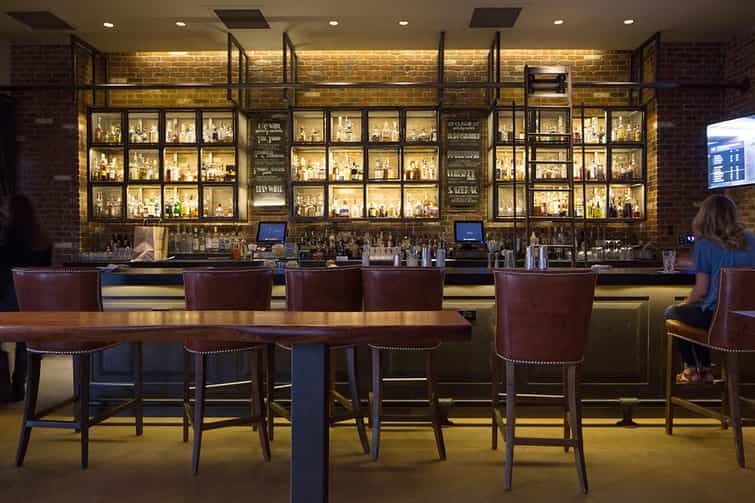
Lighting Sets the Mood
As a frame of reference regarding the role of lighting design, think of architectural design as the body of a project and interior design as the fashion. Lighting brings the emotion. Done right, it reinforces and enhances the work of architects and designers.
Interior lighting subtly evokes a variety of moods, including tranquil, peaceful, exciting, stressful, and even anger, whether the lighting is planned or not. Your chances of getting the emotional response right without a lighting designer are slim.
The designer routinely asks, "what do I want to FEEL in this space" and "what do I want those who enter to feel in the space?". The former is meant only as an exercise to understand and get to the latter.
In addition to making an architect or interior designer's work shine, lighting designers optimize the space to set the most favorable conditions for workers, customers, and visitors.
They use many techniques including direct, indirect, decorative, functional, accent, focal and sparkle lighting among others, and use color, intensity, and direction for maximum effect.
Lighting designers specify fixtures' color temperature, beam spread, size, and the controls so it all works together efficiently. The art is in using the amount of light and the style the space requires, based on the design objectives.
The Psychology of Interior Lighting Design
Knowing the science of light enables lighting designers to realize their full artistic potential. Psychology is an equally important form of science as the architecture, electrical engineering, and computer science integral to lighting design.
The lighting designer must know the tools of the art form as a painter knows brushes and paints. Only then can the vision be realized with every nuance.
Whether setting a mood or focusing attention, lighting provides cues the brain automatically follows. Different types of light are used to achieve different effects.
Lighting designers carefully consider the subtle, but strong, emotional aspects of lighting, which are profound and impact every moment of our lives.
Ambient light typically covers all surfaces in a room in an even, uniform, softer, low-intensity light. It is the fundamental base level and sets the tone of a space and provides a cue to its function.
A higher ambient level will inform the inhabitants whether they should relax, get serious, be reverent, or expend some energy. Ambient light, by itself, is a low vibration psychological stimulant similar to bread or rice in your meal. By itself, it is good and foundational, but bland and certainly not the exciting part.
Focal or accent light highlights architectural, interior design, or landscape features with directional fixtures and more intense light that draws our attention like a moth to a flame.
Our eyes are attracted to the brightest spot in the space. Good interior lighting designers never make the fixture the brightest spot unless the fixture is purely decorative and artistic.
Because of the psychology involved, lighting designers use focal lighting for many reasons, including way finding, steering attention, and setting the visual importance of objects. They call this "Defining the Visual Hierarchy."
Then, “sparkle” light adds numerous bright reflections or points of light for excitement. This further heightens the emotional stimulus of a crystal chandelier or accent lighting on glassware, jewelry, or diamonds.
Decorative fixtures are the jewelry in the space and should never be asked to be the “body” or the “fashion.” Decorative fixtures can provide some ambient lighting and focal lighting but never at the expense of looking pretty or causing glare.
Light hue, saturation, brightness, and placement (covered below) also are important psychological and physiological considerations.
Light Painting with Purpose
Lighting designers blend interior light over room surfaces the way painters layer oil on canvas. The effect can be dramatic or so understated it is felt more than seen.
Intense red tones convey excitement or danger in direct or signage lighting, while a touch of red in white ambient lighting makes it warm and comforting.
Interior lighting goals vary with the type of space and how it is used. Soft ambient light in a fine dining restaurant creates a soothing ambience that makes patrons tend to stay longer and order more high-ticket wine, drinks, and desserts.
Bright lighting in a fast food restaurant helps turn the tables over faster for selling more volume of low priced items in a given timeframe.
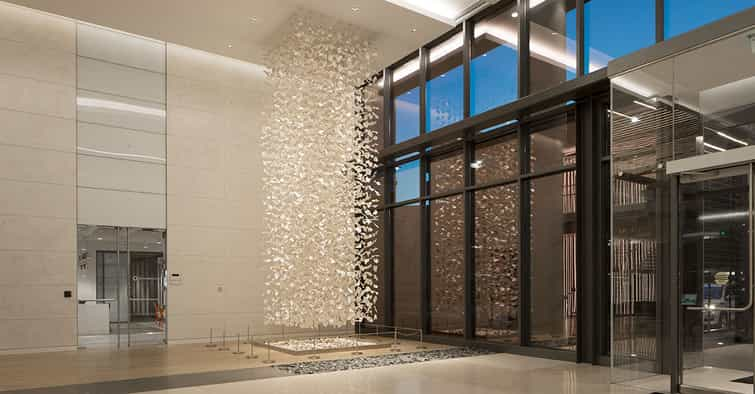
Museums use soft, indirect ambient lighting that allows direct focal lighting to call attention to paintings and sculptures while not making the spaces too dramatic to see the corners and feel safe.
The balance of ambience and focal varies with the works to be shown and museum’s style. Museum lighting is a solid example of what other spaces should emulate.
Hotel lobbies are similarly designed and lit. They should establish a welcoming feeling, helping visitors navigate their way to reception, concierge, elevators, restaurants, and other amenities and define the price point of the hotel experience.
Bring the Outside Indoors with Natural Light
Interior lighting designers incorporate natural light to the greatest extent desired in most spaces, at work or home. The sun emits all colors of visible light via electromagnetic radiation, which results in a psychologically neutral, white light that allows people to see colors at their best.
Technically, the sun is a very high color temperature of white, actually blue on the Kelvin temperature scale. But sunlight’s high intensity makes the high color temperature appear less blue, except when in contrast with warmer light of traditional incandescent or candlelight.
High color temperatures elicit more psychological energy and should be used for exercise spaces and serious spaces where maximum amount of readiness or alertness is required.
High color temperatures should be accompanied by high light levels as with sunlight; low color temperatures should be accompanied by low color temperatures such as candlelight. The Kruithof Curve shows what is considered "pleasing" and a comfortable psychology.
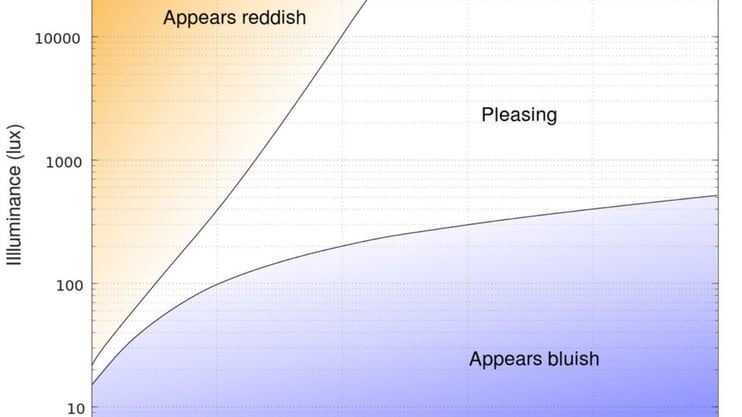
People prefer the psychology of natural light, when available. It is the first light to consider. Multiple studies have shown worker satisfaction and productivity are higher in natural light, so good lighting designers and architects use it to the greatest extent possible.
When natural light is not available they use man-made illumination to mimic natural light as closely as possible, given energy, heat, and visual balance objectives.
Lighting for Increased Productivity
The direct correlation of mood to workplace productivity is unquestioned. Illness, depression, frustration, anxiety, and elation all affect our ability to focus on work. Bad lighting at work equates to bad mood and lower productivity and job satisfaction.
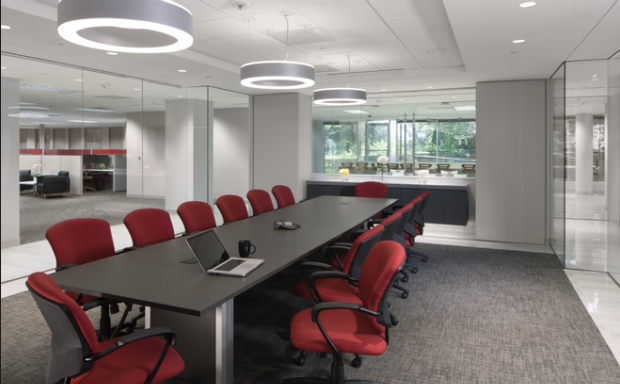
Considering the principles of ambient, focal (task) and sparkle light, interior lighting designers use natural light to full advantage. It is bright and it is free but can be a source of glare and eye fatigue.
Windows and skylights let the light in while light shelves, blinds, and shades used to control the direct sunlight bring visual balance and energy to a room.
Where natural light is not available, good designers use LED lighting instruments to mimic it closely for ambient lighting. This is where knowing the science of lighting gets important.
Light Color and Temperature
Light color, or hue, is a function of temperature, measured on the Kelvin (K) scale. As the temperature of an object (think light source) changes, it emits different colors. Here’s how it applies to a workplace.
2,000K – 2,400K = warm red to yellowish white, like a glowing fireplace. Imparts a sense of relaxation appropriate for home, lodge, hotel, restaurant, and informal surroundings.
2,400K - 3,000K = our traditional incandescent and halogen color of a warm, lower level of light. Perfect for traditional homes and hotels.
3,500K -4,000K = typical American office lighting. American culture prefers warmer temperatures than others in the Middle East, Europe, and Pacific Rim countries
4,000K – 5,500K = mid-to-cool white hues that still are welcoming, but brighter to promote more alertness. Used for photography and TV and the lower end of the sunny day range.
5,000K – 7,000K – stark and cold like an overcast winter day. This lowers melatonin for more alertness and energy needed for brainstorming.
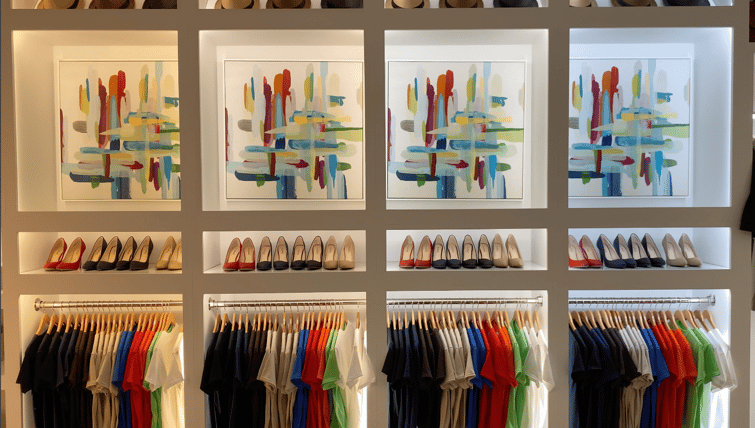
Saturation and Brightness
Saturation is a measure of the intensity of a color. For example, photo editors use a gradient on which “0” is without color and “100” is full intensity. For internal lighting designers, the Color Rendering Index (CRI) of a light source is one of the main characteristics to be specified.
CRI and Saturation are closely related. The easiest way to think about CRI is the concept of Saturation. The more intense the color, the higher the CRI and the stronger the emotional punch it packs.
Brightness of light is measured in lumens. The higher the lumen number, the brighter the light. Lumens are not the same as wattage numbers used with incandescent bulbs. For comparison, a 100-watt incandescent bulb emits about 1,600 lumens whereas a 100-watt LED can emit up to 15,000 lumens.
Bright light is better for many situations, but it can be overdone. Researchers say brighter light results in more intense emotions, positive and negative. The highest level of lighting design puts a dimmer on all fixtures so that the brightness can be controlled.
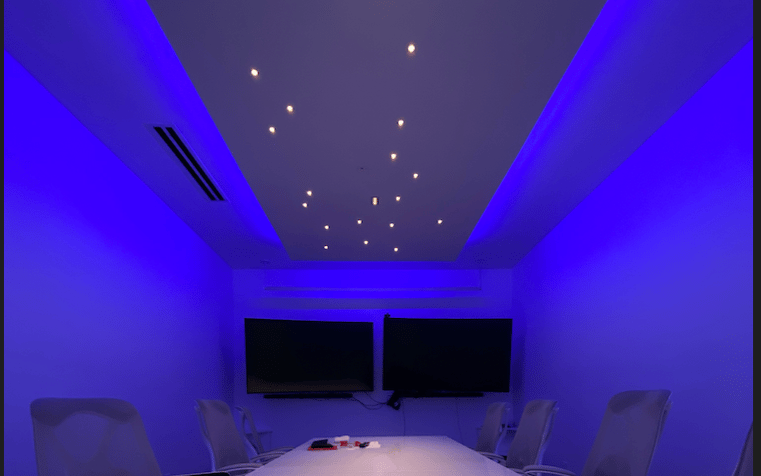
Unfortunately, fluorescent lighting, historically prevalent in many offices, is especially harsh. In addition to cranking up emotions, it also increases eye strain and headaches, mainly due to the lower CRI, spikes in the color spectrum, and the frequency of pulsating excitation of the phosphors.
LED lighting is the preferred solution because hue, saturation, and brightness are easily controlled, it generates less heat per watt, it has a longer life cycle, and LED lighting uses much less electricity.
Lighting Direction
Less apparent to people who are not lighting designers is the positioning of lighting. Overhead lighting establishes a more formal atmosphere, symbolizes midday sunlight outside. This can feel intense, create harsh shadows, and increase tension.
Light sources placed at eye level are more informal and can increase a sense of self-importance, are more flattering for the face and make people look more attractive.
Bright wall lighting creates a more spacious feel. Light expands and darkness contracts. Lighting the walls defines the space and makes it feel bigger. Wall lighting is analogous to sunset or sunrise with brightness along the horizon.
Uplighting of interior spaces mimics daytime lighting, with brightness overhead. Without a direct source it produces a cloudy day effect.

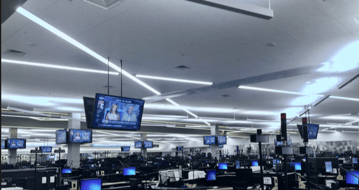
Lighting Affects Personal Health and Wellness
Knowing how these properties of light affect mood and productivity, there is a darker side to consider – how health and well-being are endangered by improper lighting. The same light that improves productivity can induce excessive stress. The problem is as fundamental as day and night.
Humans need a healthy exposure to light, preferably with sunlight to start the day. On dark winter mornings we need indoor lighting to substitute for natural lighting to get us moving.
In the same way, we need the transition from day through dusk, and then on to the dark of night to steer our brains toward rest and sleep. This rhythmic pattern is known as circadian rhythms. All living beings respond to the God-given ebb and flow and color of natural light.
The Importance of Circadian Rhythms
Circadian rhythms govern our body processes, from alertness to bowel movements, within the 24-hour sleep/wake cycle and provide other mental and physiological cues. Think of them as a type of biological clock running in the background to control things we would never remember to do.
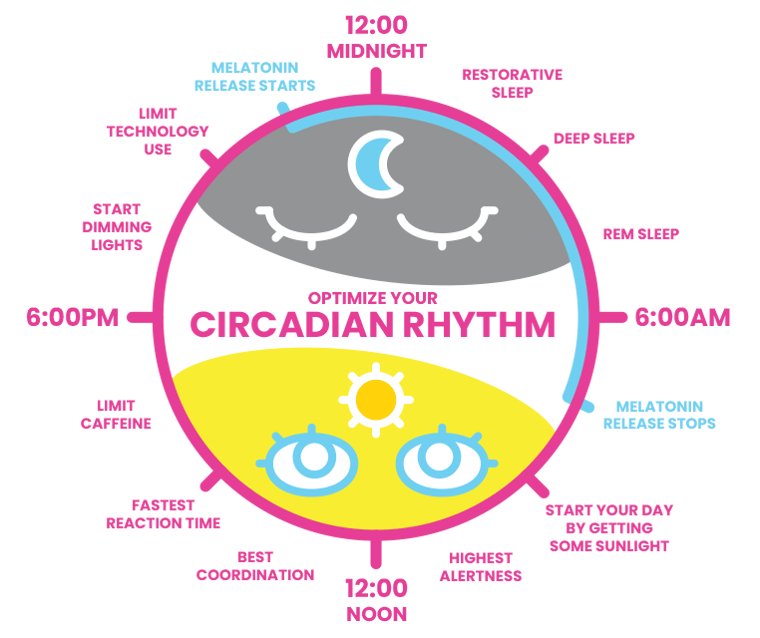
The wake/sleep cycle is one of the most critical of all. Arriving at work to natural light or illumination that mimics it is a major consideration of workplace interior lighting design.
Office light that complements natural light or serves in its place keeps people more alert and active. At home in the evening, it’s equally important to use warmer, softer reddish-yellow hues to relax and prepare for sleep.
Natural light gets very warm around sunset, then very blue for a short period of time before the full darkness of night. That process prepares us for sleep by the pineal gland releasing melatonin.
Running our internal clocks is one wellness concern; bright, intense artificial light poses a different, broader set of risks. Physicians say overexposure to artificial light, especially bright light, is linked to cancer, heart disease, obesity, diabetes, depression, reproduction, poor bone density, and other medical conditions.
Lighting to Reduce Stress
Most of these conditions are linked one way or another to stress. Stress factors and stimulants, such as caffeine, cause our adrenal glands to over produce and impair proper kidney function.
Proper kidney function is necessary to filter and remove metabolic waste. The backup of metabolic waste causes issues in certain areas of the body and causes disease. Proper light and stress reduction can improve that physiological process.
Bright light is more stressful that dimmer light. All lighting should be dimmed. Can you image having a stereo playing music and you can't adjust the volume? Intense red light can increase stress, while warm reds and yellows reduce it. Glare in any color is stressful.
The problem exists in offices, hospitals, nursing homes, and our residences. Space designed to provide a comfortable, productive atmosphere can be made needlessly stressful without proper interior lighting design.
Conversely, the right designed lighting at the proper illumination level can reduce stress and encourage happier more productive and fulfilled living.
Lighting Design for Customer Experience
Customers and clients are subject to the same psychology of lighting design and mood-setting as employees. Well-designed interior lighting makes it easier for people to understand what you offer, the level of the product or service, and then do business with you.
Brick and mortar retailers should fully exploit this advantage, one that online stores never can match. Not all interior lighting goals are the same, however, nor should they be.
Each space has its own set of goals and focus, driven by the occupants' visual requirements, average age, and the company's style, target market and cost of goods or services.
In addition to making an architect or interior designer's work shine, lighting designers optimize the space to set the most favorable conditions for workers, customers, and other visitors.
In addition to making an architect or interior designer's work shine, lighting designers optimize the space to set the most favorable conditions for workers, customers, and other visitors.
Lighting Supports Function
Expect to find basic retail lighting – overhead LED lights, maybe still some metal halide or fluorescent – in big box and fast food stores, where clean and bright are important.
In 24-hour convenience stores bright light promotes safety and makes it uncomfortable to stay long. Bright lighting picks up the operational pace in these stores, where lower prices and margins require faster customer turnover and higher volume.
Department stores typically add accent lighting to make products more visible and call attention to them. Some high-end retailers, such as a jewelry stores and fashion apparel shops, will go all out to create a dazzling customer experience, not just with lighting the merchandise, but with the store itself.
The Many Advantages of LED Lighting
The availability of LED lighting, with its dramatically lower operating costs and the ability to control it from a computer or smart phone, is forcing retailers to up their interior lighting design game or be left behind.
LED lights can produce all the colors of the rainbow and simultaneously turn the hue and intensity up or down, as the situation requires.
Take the case of a fine clothing retail store. The customer experience begins with well-lit window displays that makes people want to take a closer look at that Armani suit.
Inside, the carefully planned use of color and brightness in ambient and focal lighting lays out a path that leads to new or preferred products, special promotions, and high-end merchandise.
The quality of the Armani is easy to see with the focal lighting that brings out the subtle tones, texture, and fine workmanship of the fabric. Dressing room lighting is from face level and will confirm it looks good on you.
What just happened? Contrasting light captured the shopper’s eyes, demanded his attention, and led him to the product in a way no uniformly dim or bright lighting can.
Showing merchandise in its best light not only makes products easier to see and appreciate; it also builds trust in the retailer. The retailer wants you to see clearly that there is nothing to hide. This article discusses in more detail how customer experience is shaped by lighting design.
Elevate Brand Image
Companies and other organizations work years to build their brands and the feelings they elicit. Whether perceived as low cost, innovative, high-quality, or market leader, brands convey the public image of an organization and what it stands for.
Logos and signage are the most visible and promoted as factors in brand identity. Architecture also is a consideration (think Golden Arches). More recently, architectural lighting has become a factor in brand promise, expectations, and image.
Using the example of the high-end men’s clothier, interior lighting design played a significant role in establishing the image of a high-end retailer. Soft ambient lighting welcomes and relaxes visitors; they will not be rushed.
The store’s lighting fixtures would have to be high-end, too, whether employing track lighting, sconces, overhead, or some combination. Light colors must be consistent with the brand’s image, as well.
In fine dining restaurants the focus is on the table with accent lighting for the table and candles for nighttime dining. The added lighting at the table makes the food look great and the faces of those you are with look great, too. This subtly heightens the dining experience and keeps your focus on the two most important items in the room.
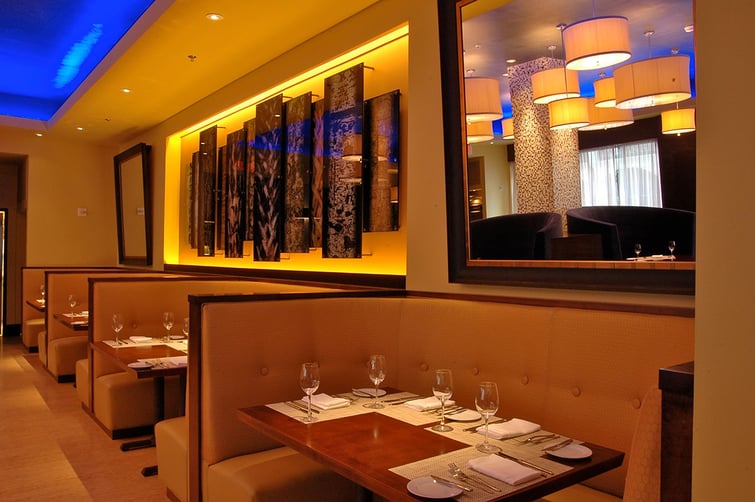
Brand Elevation Above and Beyond
The airline industry is taking interior lighting design to new heights. Most airlines fly the same aircraft as their competitors. They make the same announcements, and uniforms look strikingly similar. Cabin lighting provides a powerful means of differentiation.
In the mid-2000s, Virgin Atlantic abandoned yellowish-green fluorescent cabin lighting in favor of a warmer and more relaxing pink-purple. It was a “Wow!” moment. The change made flying a little less stressful for passengers. It also started a trend.

New airliners now come equipped LED lighting systems that can dial up some 16 million colors (far more than the human eye can detect) and a dazzling array of visual effects. Airlines have their own designers who work with aircraft manufacturers to build in a memorable brand experience for their captive audiences.
The experience may include lighting to simulate sunset, with soft tones to induce melatonin production and sleepiness. Near the end of the flight, gradually increasing cabin light mimics sunrise to wake people gently.
Albuquerque International Airport furthers the experience with LED mood lighting in varying colors at arrival and departure levels and baggage claim areas.
Conclusion
Good lighting design for interior spaces sets the mood for people who use the space by considering their psychological needs as well as visual requirements. This requires skillful use of hue, intensity, brightness, and direction.
Business lighting directly affects productivity, wellness, customer experience, and the organization’s brand. Designers use natural light whenever possible because of its brightness and the true colors it lets us see – and it is free.
Lighting designers use focal light to draw attention or provide bright work light. Soft ambient light directed from walls and ceilings helps set a relaxed mood, while intense, bright light can induce stress. “Sparkle” light may be used to add a festive or playful touch.
Top architects and developers use interior lighting designers to ensure the space delights and enables the people using it, while showing their work in the best possible light.

